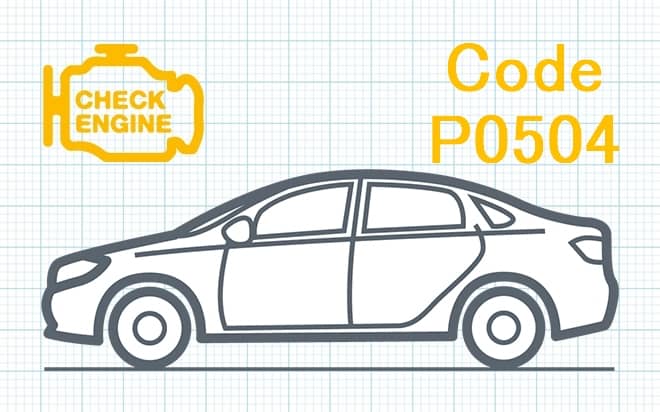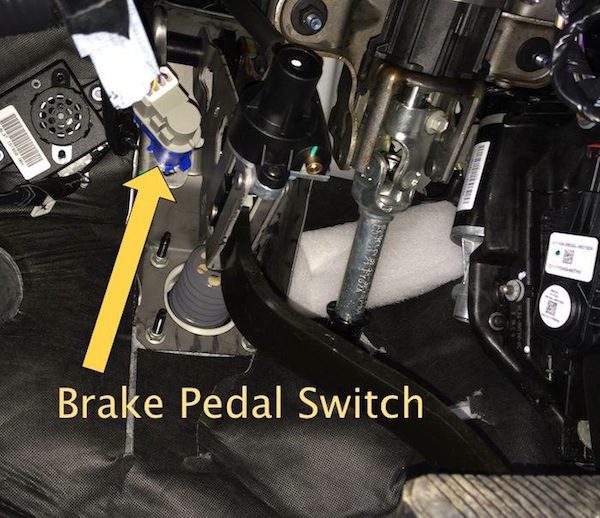
P0504 A / B Brake Switch Correlation Code
Content
DTC P0504 - OBD-II Data Sheet
A / B brake switch correlation
This Diagnostic Trouble Code (DTC) is a generic transmission code, which means it applies to OBD-II equipped vehicles. Although general, specific repair steps may differ depending on the brand / model.
When a malfunction is detected in the vehicle's brake light switch, the PCM (Powertrain Control Module) will write code P0504 and the Check Engine light will come on.
What does code P0504 mean?
Your vehicle's powertrain control module (PCM) has set this P0504 code in response to a detected brake light circuit failure. The vehicle computer monitors all circuits for abnormalities such as no voltage or out of range.
The brake light switch is connected to multiple circuits, each of which can lead to a hazardous situation. The brake switch itself consists of two signal outputs, and if there is a fault in the switch, it is detected and sets this code. This is an inexpensive offer in terms of the cost of the part or the labor required to replace it. The safety factor needs to be repaired as soon as possible.
Symptoms
The first sign that your PCM has stored a P0504 code is most likely to be the Check Engine light on. Apart from this, you may also notice other symptoms, including:
- Pressing the brake pedal does not activate or deactivate the vehicle's cruise control.
- One or both brake lights do not come on when the brake pedal is pressed.
- One or both brake lights remain on even after you take your foot off the brake pedal.
- Pressing the brake pedal at high speeds stops the engine.
- The shift lock system is not working properly.
- The brake lights will either light up permanently, or they will not light up when the pedal is depressed.
- It will be difficult or impossible to leave the park
- The vehicle may stall when the brakes are applied at cruising speed.
- Cruise control is not activated
Possible causes of error З0504
There are several components in this circuit, any of which is capable of cracking the circuit enough to install this code.
- The most common is the brake light switch, which fails due to wear.
- The brake light fuse breaks down from time to time due to moisture entering the circuit or the brake light burnout.
- Another reason often caused by water entering the lenses is a malfunctioning brake light.
- Wire harness, more specifically, connectors, loose or pushed out pins will cause a correlation problem between the switch and the PCM.
- Finally, the PCM itself could fail.
Diagnostic steps and possible solutions
The brake light switch is located under the instrument panel at the top of the brake pedal lever. The brake booster raises the pedal to the fully extended position. The brake light switch is mounted on the cross member support bracket directly behind the brake pedal mounting bracket. The only way to access the switch is to push the front seat back, lie on your back and look up under the dashboard. You will see a switch bracket at the top of the brake pedal lever. The switch will have four or six wires.
The switch is housed in a bracket so that its drive rod contacts the brake pedal lever when the pedal is fully extended. At this point, the switch is depressed by the brake pedal lever, which cuts off the current. When the brake pedal is depressed, the lever extends, including the switch and brake lights. When the pedal is released, the lever presses the rod again, disabling the brake lights.
Diagnostic steps
- Ask an assistant to check the brake lights. Make sure they work by turning them on and off and that the lamps are in good condition.
- If the brake lights are on continuously, the brake light switch is incorrectly adjusted or defective. The same applies if they don't work. Move the driver's seat back and look under the dashboard. Squeeze the tabs of the electrical connector located on the brake light switch and disconnect the connector.
- Use a voltmeter to check the voltage on the red wire in the connector. Connect the black wire to any good ground and the red wire to the red wire terminal. You should have 12 volts, if not, check the wiring to the fuse box.
- Connect the plug to the switch and check the white wire with the pedal depressed. You should have 12 volts with the pedal depressed and no voltage with the pedal extended. If no voltage is present, replace the brake light switch. If voltage is present at the white wire with the pedal extended, replace the switch.
- If the switch is in an adjustable category, check the setting. The switch should fit snugly against the pedal arm and fully depressed.
- If the brake lights work fine but the code is still known, check the remaining wires on the brake light switch. Remove the connector and check the remaining wires for power. Note the location of the power wire and replace the connector. Wrap the back of the wire adjacent to the power wire while the pedal is depressed. If there is no power, replace the switch.
- If the pedal was pressed during the last test, the switch is OK. The problem exists in the wiring to the computer or in the computer itself.
- Locate the computer and the STP terminal rear sensor on the computer to ground. If the voltmeter shows 12 volts, the computer is faulty. If the voltage was low or absent, replace or repair the harness from the computer to the switch.
Additional notes
Be aware that some vehicles are equipped with driver-side knee airbags. So be careful when handling airbags.
Here is the brake pedal switch featured on a 2011 Ford F-150. 
COMMON ERRORS WHEN DIAGNOSING CODE P0504
If the brake light does not come on when the driver presses the brake pedal, they often assume that the problem is a burned out light bulb. You may then change the light bulb and find that this does not solve the problem. If there is a problem with the brake switch or circuit, replacing a blown brake fuse could also be a mistake, as the underlying problem is likely causing the fuse to blow again.
HOW SERIOUS CODE P0504 IS?
It is very dangerous if the brake lights do not turn on and off when the brake pedal is pressed or released. Traffic from behind can't tell if you want to slow down or need to come to a sudden stop, and an accident could easily happen. Likewise, if you do not disengage the cruise control system by depressing the brake pedal, you could be in another dangerous situation. So you can see that code P0504 is very serious and needs to be treated immediately.
WHAT REPAIRS CAN FIX CODE P0504?
In most cases, troubleshooting the cause of a P0504 code is fairly simple. Depending on what the underlying problem is, some of the more common repairs include:
- Replacing a burnt out brake light bulb.
- Repair or replace the wires or connectors in the wiring harness or brake switch circuit.
- Replacing the brake switch.
- Replacing a blown brake light fuse.
ADDITIONAL COMMENTS REGARDING CODE P0504 CONSIDERATION
In addition to potentially dangerous situations on the road, a code P0504 can also cause an emissions test to fail. While the brake light switch does not directly affect the vehicle's emissions, it does light up the check engine light, causing the vehicle to fail the OBD II emissions test.
Need more help with your p0504 code?
If you still need help with DTC P0504, post a question in the comments below this article.
NOTE. This information is provided for informational purposes only. It is not intended to be used as a repair recommendation and we are not responsible for any action you take on any vehicle. All information on this site is protected by copyright.

